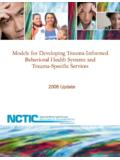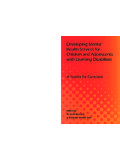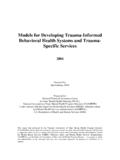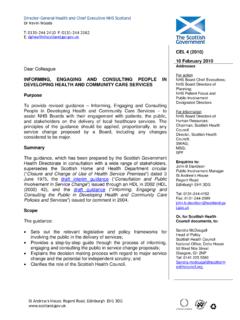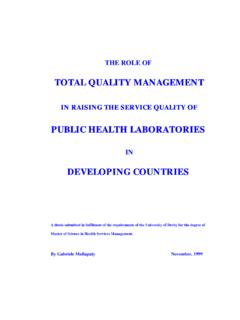Transcription of CHC Community Services Training Package …
1 CHC Community Services Training Package version 1 CHCECE007 Develop positive and respectful relationships with children Learner guide version 1 Training and Education Support Industry Skills Unit Meadowbank Product Code: 5772 SAMPLE TAFE NSW ( Training & Education Support, Industry Skills Unit Meadowbank) 2013 TAFE NSW ( Training & Education Support, Industry Skills Unit Meadowbank) 2012 CHCECE007 Develop positive and respectful relationships with children Unit code Unit name Acknowledgments The TAFE NSW Training and Education Support Industry Skills Unit, Meadowbank would like to acknowledge the support and assistance of the following people in the production of this learner resource guide: Writer: Louise Holz Teacher, Children s Services TAFE NSW Contributors.
2 Helen Lane, Sarah Murray, Lisa Wallmeyer Teachers, Children s Services TAFE NSW Reviewer: Deborah Peters Teacher, Children s Services TAFE NSW Project Manager: Gail Horwood Education Programs Manager Child and Family Services TAFE NSW Enquiries Enquiries about this and other publications can be made to: Training and Education Support Industry Skills Unit, Meadowbank Meadowbank TAFE Level 3, Building J, See Street, MEADOWBANK NSW 2114 Tel: 02-9942 3200 Fax: 02-9942 3257 Further acknowledgments A considerable amount of the material in this learner resource has been developed from the following TAFENSW resource: CHCIC301E Interact effectively with children, version 2 (2012) SAMPLE TAFE NSW ( Training & Education Support, Industry Skills Unit Meadowbank) 2013 TAFE NSW ( Training & Education Support, Industry Skills Unit Meadowbank) 2012 CHCECE007 Develop positive and respectful relationships with children Unit code Unit name ISBN 978-1-74236-480-3 The State of New South Wales, Department of Education and Training , TAFE NSW, Training and Education Support Industry Skills Unit, Meadowbank, 2013.
3 Copyright of this material is reserved to TAFE NSW Training and Education Support Industry Skills Unit, Meadowbank. Reproduction or transmittal in whole or in part, other than for the purposes of private study or research, and subject to the provisions of the Copyright Act, is prohibited without the written authority of, TAFE NSW. Training and Education Support Industry Skills Unit, Meadowbank SAMPLE TAFE NSW ( Training & Education Support, Industry Skills Unit Meadowbank) 2013 TAFE NSW ( Training & Education Support, Industry Skills Unit Meadowbank) 2012 CHCECE007 Develop positive and respectful relationships with children Unit code Unit name Table of Contents 7 1. General introduction.
4 7 2. Using this learner guide .. 7 3. Prior Knowledge and Experience .. 9 4. Unit of competency overview .. 10 5. Assessment .. 10 Section 1 - Communicating and interacting positively with children .. 13 Communicating with children .. 13 Age appropriate communication and language styles .. 15 Strategies for positive communication .. 24 Appropriate and inclusive verbal and non-verbal communication .. 30 Culturally sensitive communication .. 32 Caring and respectful interactions .. 33 Forming positive relationships .. 41 Section 2 - Promoting positive behaviours .. 45 Understanding children s behaviours .. 45 Developing self esteem .. 54 Considering children with developmental challenges .. 56 Different styles of behaviour management.
5 59 Promoting positive behaviour .. 63 Behaviours of concern .. 77 Section 3 - Collaborating with children .. 91 Exploring collaboration and how children learn .. 91 Value of children s input and ideas .. 95 Acting on children s suggestions in a positive manner .. 101 Section 4 - Respecting similarities and differences .. 107 Encouraging respect for similarities and differences .. 107 Values and attitudes .. 110 Addressing difference and ensuring equity .. 111 Talking about likes and dislikes .. 116 Section 5 - Supporting children in decision making .. 121 Involving children in planning and decision making .. 121 A problem solving model .. 125 Limitations of resources .. 127 Implementing children s ideas .. 129 Answers to 137 Section 1.
6 137 Section 2 .. 140 Section 3 .. 141 Section 4 .. 142 Section 5 .. 143 References .. 145 Resources .. 147 Legislation and policy requirements .. 147 Journals: .. 153 Videos/ DVD s/ CDRoms .. 153 SAMPLE TAFE NSW ( Training & Education Support, Industry Skills Unit Meadowbank) 2013 TAFE NSW ( Training & Education Support, Industry Skills Unit Meadowbank) 2012 CHCECE007 Develop positive and respectful relationships with children Unit code Unit name Organisations and web sites .. 154 Resource Evaluation Form .. 157 SAMPLE TAFE NSW (TES, Industry Skills Unit Meadowbank) 2013 Page 11 of 160 TAFE NSW ( Training & Education Support, Industry Skills Unit Meadowbank) 2012 Page 11 of 160 CHCECE007 Develop positive and respectful relationships with children Unit code Unit name About this unit This unit describes the skills and knowledge required by educators working with children to ensure they can develop and maintain effective relationships and promote positive behaviour.
7 This unit applies to educators who work with children in a range of education and care service settings. Underpinning this unit is knowledge of the relevant National Quality Standard quality areas, standards and elements, sections of Education and Care Services National Law and Regulations, and aspects of the relevant learning framework, including; National Quality Standard Quality Areas 1, 4, 5, 6 and 7 Education and Care Services National Regulation, Parts , and Approved Learning Framework Early Years Learning Framework or My Time, Our Place Additionally, whilst studying this unit you will need to access a range of other resources and documents, including.
8 Raising Children Network website Early Childhood Australia Unicef Nixon, D and Aldwinckle, M. 2007. Exploring: Child development from three to six years. 2nd edition. Porter, L. (2006) Children are people too. A parent s guide to young children s behaviour. 4th ed Intellokids ECA s Code of ethics. ACECQA Details of, and/or links to all required resources are listed in the resources section at the rear of this Learner Resource. In some cases you will need to use a computer and the internet to access the required resources. Sometimes internet pages can be moved over time if you have difficulty finding the required resources with the link provided, try a google search, and if that fails, ask your facilitator for assistance.
9 SAMPLE TAFE NSW (TES, Industry Skills Unit Meadowbank) 2013 Page 13 of 160 TAFE NSW ( Training & Education Support, Industry Skills Unit Meadowbank) 2012 Page 13 of 160 CHCECE007 Develop positive and respectful relationships with children Unit code Unit name Section 1 - Communicating and interacting positively with children Communicating with children Communicating is a way of imparting or exchanging information as well as needs and feelings in the form of speech, writing, gestures and more. When we communicate we connect with others in forms which we are comfortable with and which are appropriate to the situation and circumstance. A large proportion of our waking time is spent communicating either by talking, listening, writing or reading.
10 Communication involves some form of interaction and is often a two way process which requires and values the input, feelings and intentions of other parties. Communication is a day to day function and is important for survival and aids us in developing social networks and in being successful in our pathways personally and professionally. It begins at birth when we communicate basic needs of hunger, discomfort, pain, contentment and is essential to our survival and development. We continue refining and experimenting with forms of communication as we grow and develop. Communication helps us form positive relationships with others. Communication takes many forms such as verbal, non-verbal and written.








